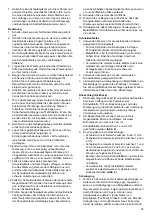
10
4. During operation, keep bystanders or animals at least
15 m away from the tool. Stop the tool as soon as
someone approaches.
5. Before operation, examine the work area for stones or
other solid objects. They can be thrown or cause
dangerous kickback and result in serious injury and/or
property damage.
6.
WARNING:
Use of this product can create dust
containing chemicals which may cause respiratory or
other illnesses. Some examples of these chemicals
are compounds found in pesticides, insecticides,
fertilizers and herbicides. Your risk from these
exposures varies, depending on how often you do this
type of work. To reduce your exposure to these
chemicals: work in a well ventilated area, and work
with approved safety equipment, such as those dust
masks that are specially designed to filter out
microscopic particles.
Electrical and battery safety
1. Do not expose the tool to rain or wet conditions. Water
entering the tool will increase the risk of electric shock.
2. Do not use the tool if the switch does not turn it on and
off. Any tool that cannot be controlled with the switch
is dangerous and must be repaired.
3. Prevent unintentional starting. Ensure the switch is in
the off-position before installing a battery pack, picking
up or carrying the tool. Carrying the tool with your
finger on the switch or energising the tool that have
the switch on invites accidents.
4. Recharge only with the charger specified by the
manufacturer. A charger that is suitable for one type of
battery pack may create a risk of fire when used with
another battery pack.
5. Use the tool only with specifically designated battery
packs. Use of any other battery packs may create a
risk of injury and fire.
6. When battery pack is not in use, keep it away from
other metal objects, like paper clips, coins, keys, nails,
screws or other small metal objects, that can make a
connection from one terminal to another. Shorting the
battery terminals together may cause burns or a fire.
7. Under abusive conditions, liquid may be ejected from
the battery; avoid contact. If contact accidentally
occurs, flush with water. If liquid contacts eyes, seek
medical help. Liquid ejected from the battery may
cause irritation or burns.
Putting into operation
1. Before assembling or adjusting the tool, remove the
battery cartridge.
2. Before handling the cutter blade, wear protective
gloves.
3. Before installing the battery cartridge, inspect the tool
for damages, loose screws/nuts or improper
assembly. Sharpen blunt cutter blade. If the cutter
blade is bent or damaged, replace it. Check all control
levers and switches for easy action. Clean and dry the
handles.
4. Never attempt to switch on the tool if it is damaged or
not fully assembled. Otherwise serious injury may
result.
5. Remove any adjusting key or wrench before turning
the tool on. A wrench or a key left attached to a
rotating part of the tool may result in personal injury.
6. Adjust the shoulder harness and hand grip to suit the
operator’s body size.
7. When inserting a battery cartridge, keep the cutting
attachment clear of your body and other object,
including the ground. It may rotate when starting and
may cause injury or damage to the tool and/or
property.
Operation
1. In the event of an emergency, switch off the tool
immediately.
2. If you feel any unusual condition (e.g. noise, vibration)
during operation, switch off the tool. Do not use the
tool until the cause is recognized and solved.
3. The cutting attachment continues to rotate for a short
period after turning the tool off. Don’t rush to contact
the cutting attachment.
4. During operation, use the shoulder harness. Keep the
tool on your right side firmly.
5. Do not overreach. Keep proper footing and balance at
all times. Watch for hidden obstacles such as tree
stumps, roots and ditches to avoid stumbling.
6. Never work on a ladder or tree to avoid loss of control.
7. If the tool gets heavy impact or fall, check the
condition before continuing work. Check the controls
and safety devices for malfunction. If there is any
damage or doubt, ask our authorized service center
for the inspection and repair.
8. Do not touch the gear case. The gear case becomes
hot during operation.
9. Take a rest to prevent loss of control caused by
fatigue. We recommend taking a 10 to 20-minute rest
every hour.
10. When you leave the tool, even if it is a short time,
always remove the battery cartridge. The unattended
tool with the battery cartridge installed may be used by
unauthorized person and cause serious accident.
11. If grass or branches get caught between the cutting
attachment and guard, always turn the tool off and
remove the battery cartridge before cleaning.
Otherwise the cutting attachment may rotate
unintentionally and cause serious injury.
12. If the cutting attachment hits stones or other hard
objects, immediately turn the tool off. Then remove the
battery cartridge and inspect the cutting attachment.
13. Check the cutting attachment frequently during
operation for cracks or damages. Before the
inspection, remove the battery cartridge and wait until
the cutting attachment stops completely. Replace
damaged cutting attachment immediately, even if it
has only superficial cracks.
14. Never cut above waist height.
15. Before starting the cutting operation, wait until the
cutting attachment reaches a constant speed after
turning the tool on.
16. When using metal blades, swing the tool evenly in
half-circle from right to left, like using a scythe.
Cutting attachments
1. Use an applicable cutting attachment for the job in
hand.
– Nylon cutting heads (string trimmer heads) are
suitable for trimming lawn grass.











































